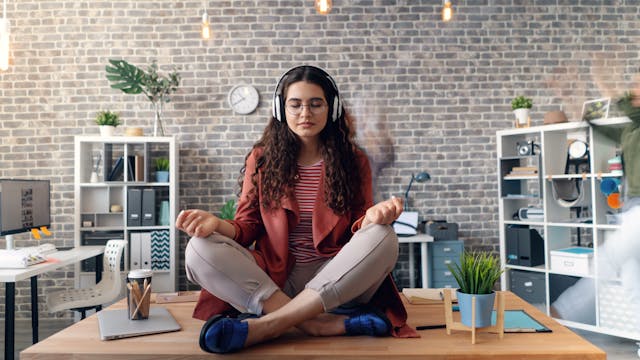Geography of Work (Part 2) The Sensory Space
In Part 1 of our Geography of Work series, we explored how physical spaces, from home offices to corporate headquarters, influence focus, collaboration, and autonomy. But there’s more to wellbeing at work than simply where you sit. In Part 2, we take a closer look at how often-overlooked sensory elements, like lighting, noise, ergonomics, and social dynamics, profoundly influence how we feel, think, and perform at work. Whether remote, hybrid, or on-site, optimising your environment can make the difference between surviving and thriving at work.
Lighting, Noise, and Ergonomics
Sensory inputs like lighting, noise, and the ergonomics of your work area all significantly impact your well-being at work. Specifically, they have a powerful psychological and physical influence, determining your comfort, energy levels, and ability to focus on work throughout the day.
Lighting
You can lighten the load by boosting your exposure to natural light in your workspace. Unlike artificial fluorescent lighting, offices with abundant natural light can enhance alertness and boost morale. It can also support better sleep, as workers exposed to natural light were found to get 46 more minutes of sleep per night than those who aren’t. If you work in a commercial office, consider asking if you can move your desk closer to a window. You may also find that it leads to better sleep.
Noise
If you work in a noisy, open-plan office, you’ll likely experience stress, distraction and even headaches during your workday.
While some noise in a workplace is inevitable, when it starts to impact your well-being and productivity, it’s time to make some changes.
What can you do to reduce noise?
- Be mindful of the volume of your own voice, especially if you’re speaking on the phone.
- Ensure your personal devices, like mobile phones, are kept on low volume or silent at work to avoid adding to office noise.
- If you need to take a call on your mobile phone, consider going outside or to a quiet room.
- If noise bothers you at work, take temporary noise breaks, such as going for a short walk outside or drinking water.
- You can also curate your own sound to escape the noise. Think soft music or white noise by wearing noise-cancelling headphones to block chatter and increase your productivity and creative flow.

Ergonomics
Your health and well-being at work are hugely influenced by how comfortable you are in your workspace. Many people spend long hours sitting at a desk, leading to poor workstation ergonomics and serious consequences, including discomfort, fatigue, and even long-term injury. Many practical strategies can be implemented to improve ergonomics, including height-adjustable desks, wrist supports, and monitor stands, which reduce fatigue and boost long-term health. Good ergonomics is important for employees, but the benefits also flow on to employers, as upgrading workstations could see a drop in sick leave related to musculoskeletal issues.
Improve your personal ergonomics:
- Adjust your chair height so your feet are flat on the ground, and your knees are at a 90-degree angle.
- Position your monitor so that your eyes are slightly below eye level.
- Adjust your keyboard so your arms rest comfortably at your sides, with elbows at a 90-degree angle.
- Incorporate regular exercise, such as stretching, yoga, or other low-impact exercises, into your daily work routine.
- Maintain good posture by sitting straight, relaxing your shoulders, and avoiding hunching over your desk.
How Aesthetics Influence Well-being at Work
Have you noticed that your mind starts to feel scattered when you work in a cluttered, disorganised workspace? That’s because the visual environment at work influences your mindset, whether calm, chaotic, focused, or fatigued. So, making deliberate design choices is crucial for well-being at work because it supports improved mental clarity, productivity and even emotional regulation.
How to improve the aesthetics simply:
- Allocate a ’10-minute tidy rule’ at the end of each workday to reduce excess paperwork, tangled cables, and visual mess, which increases mental load
- If you have some control over your environment, incorporate biophilic design (plants, natural elements), calming colours (greens, blues), and clean lines to promote productivity.
Workplace Culture – Stress or Strength?
You might have the ideal desk and ergonomic chair, but achieving success is challenging if your work culture is toxic or isolating. Workplace culture is crucial in how included and supported you feel, whether in person or virtual environments.
Your social environment is just as important as your physical one. Trust, leadership, and connection significantly enhance productivity and job satisfaction.
High-performing teams are built on psychological safety, which allows team members to ask questions and make mistakes without fearing negative consequences. If you lead teams in a corporate office or remotely, it’s crucial to introduce systems that promote psychological safety.
Tips to improve workplace culture
- Implement “Feedback Fridays” as a practical way to promote transparency and connection, which will ultimately lead to psychological safety.
- Adopt a supportive, autonomy-driven leadership style to encourage innovation.
- Recognise employees for their hard work and dedication through reward programs, awards, and social media recognition.
- Support well-being programs that promote employee wellness.
You don’t need to move to a new city or build a fancy office to improve your work geography. Small adjustments to your lighting, layout, and communication can shift your mindset about how you feel and perform daily. Every detail in your environment plays a part in shaping your workday and your potential. Whether you’re aiming to boost focus, promote well-being, or lead a more resilient team, now’s the time to look closer at your surroundings.
Do you need support with professional development strategies to support your well-being at work? Contact one of our Course Consultants today on 1300 76 2221 or via Live Chat.




